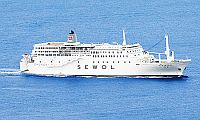 Are passenger ro-ro ferries inherently unsafe?
Are passenger ro-ro ferries inherently unsafe?
No one knows why the passenger ro-ro ferry Sewol capsized last Wednesday off the south-west coast of Korea. There are indications that poor crew training and inadequate safety and evacuation procedures may have contributed to the deaths of more than 50 and the likely loss of more than 200 passengers and crew who remain missing. Why the ship capsized, however, is still an unanswered question. It is an important question because many similar ferries are operating around the world, carrying thousands of passengers and crew every day. Passenger ro-ro ferries are an extremely efficient means of moving passengers and cargo. Unfortunately, their safety record is disturbing.
Typical passenger ro-ro ferries carry passengers on the upper decks while carrying automobiles, trucks, and other wheeled vehicles on the lower deck or decks. They are called ro-ros, an abbreviation for roll-on/roll-off, because cargo is loaded and discharged by literally rolling on and rolling off, using ramps built into the ship. The Sewol also carried containers on its forward deck in front of the deck house.
Passenger ro-ro ferries have a much greater tendency to capsize than most other types of ship. The large and relatively open roll-on roll-off decks are vulnerable to cargo shifting, as well as to flooding. If the lower deck cargo is not properly secured and shifts to one side, it can induce listing that can lead to capsize. Flooding has an even more dramatic effect. When water enters the lower deck, the effect of the water’s sloshing, called the free surface effect, can quickly destabilize the ship. At this point there is no evidence that flooding occurred on the lower deck of the Sewol . Nevertheless, the resulting capsize looks disturbingly similar to that of other ro-ro casualties of the past. Despite increases in safety regulations, things have not changed too significantly in over 60 years. Here are four notable examples:
In 1953, the MV Princess Victoria, one of the first passenger ro-ro ferries sank in the North Channel after damage to a stern ramp door in heavy weather, flooding the ro-ro deck, killing 133 passengers and crew.
The passenger ro-ro ferry Herald of Free Enterprise capsized suddenly, in roughly 90 seconds, shortly after leaving the Belgian port of Zeebrugge on the night of March 6, 1987, killing 193 passengers and crew. A forward door had been left open, allowing water on the ro-ro deck. The loss of life could have been much greater if the ship had sunk in deep water. Fortunately, she rolled over on her side on a sand bar.
On September 28, 1994, the passenger ro-ro ferry Estonia capsized and sank in the Baltic Sea with the loss of 852 lives. The ship sank after the bow ramp doors were damaged in heavy weather, allowing flooding on the ro-ro deck.
The MS al-Salam Boccaccio 98, an Egyptian passenger ro-ro ferry capsized and sank on February 3, 2006 in the Red Sea with the loss of more than 1,000 passengers and crew. In fighting a fire in the engine room, water accumulated on the ro-ro deck, destabilizing the ship.
While the these tragic sinkings all had different causes — operator error, structural damage in heavy seas, and the consequences of fire fighting — the results were the same. Safety regulations have been tightened and improved since the sinking of these vessels, nevertheless, the large and open ro-ro decks inherent in the ferry design remain a major risk. The tendency for these ships to capsize before sinking greatly increases the chances of trapping passengers below deck.
The two worst non-military maritime disasters in history each involved passenger ro-ros, which also capsized. The MV Le Joola, was a Senagalese ferry which capsized and sank in 2002 with a loss of at least 1,863 passengers and crew. The capsize was blamed on a variety of factors, including heavy weather, overloading and possible negligence. The MV Doña Paz, the worlds worst non-military disaster, was a Philippine ferry sank after colliding with the tanker MT Vector on December 20, 1987. The ship was enveloped in fire and capsized before sinking, with an estimated loss of 4,386 people,.
It is too soon to know what caused the capsize and sinking of the Sewol. Fortunately, she was carrying only about half her rated passenger capacity. The ship was 20 years old. She could have suffered a structural failure. Her cargo might have been poorly secured and shifted suddenly. She could have suffered a collision with another vessel or possible run aground, as was initially suggested, though these possibles, now seem less likely. Whatever the initial cause of the sinking may have been, the capsizing of the ship looks very much like the sinkings of the other passenger ro-ro ferries. Tragically, the inherent risk of large ro-ro decks on passenger ferries has never fully been addressed.
The video below, first broadcast in 2000, looks at the risks of ro-ro ferries sinking.

SEAWOLD:
Some marine engineers locally believe it was a combination of modifications making her inclined to be top heavy and unsecured cargo shifting wheh she made the sharp turn.
It will be interesting to see what the investigation concludes. If the VCG of the ship rose due to modifications to the ship, the operators should have been able to account for the change and should have also been aware of it. If cargo shifted, they operators obviously did a poor job securing them. There needed to be some form of downflooding for the ship to continue to capsize, which could be either a design or an operations issue.